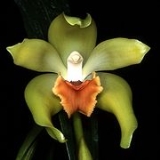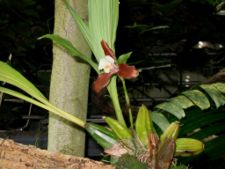
Lycaste
Encyclopedia
Lycaste, abbreviated as Lyc in horticultural trade, is a genus of orchids that contains about 30 species with egg-shaped pseudobulb
s and thin, plicate (pleated) leaves
.
s, like all orchid blooms, have three petal
s and three sepal
s. The petals are typically yellow, white, or orange, and the sepals are yellow, orange, green, or reddish brown. The petals and sepals may be marked sparsely or densely with red, reddish purple, purple, or reddish brown spots. The lip
(ventral petal) may be very similar to the other two petals, as in Lycaste aromatica or Lycaste brevispatha, or colored quite distinctively, as in several subspecies and varieties of Lycaste macrophylla. Most Lycaste flowers are medium in size, averaging about 5 to 10 cm, but Lyc. schilleriana is 16-18 cm across. Some Lycaste blooms have a unique fragrance - the scent of Lyc. aromatica has been variously described as cinnamon or clove. The blooms of the species Lyc. cochleata, consobrina, and cruenta also have a pleasant scent.
), recognize additional subspecies and varieties of Lycaste, as well as alba (white) forms of several species.
The Lycastes have been divided into four sections, one of which has two subsections:
All but two of the Deciduosae have spines at the apices of their pseudobulbs, that become exposed when the leaves are dropped - the exceptions are a Xanthanthae species, Lycaste lasioglossa, and a Paradeciduosae species, Lycaste tricolor. Both of these species lack spines, and may bloom when leaves are still present.
 The recognized Xanthanthae species include:
The recognized Xanthanthae species include:
The Paradeciduosae species include:
The Macrophyllae form a large complex, with subspecies and varieties that can be considered to be in the process of differentiating into new full species. The Macrophyllae species include:

The Fimbriatae species include:
Natural hybrids :
Hybrids
A recently published (2003) revision of Lycaste by Henry Oakeley and Angela Ryan split off most of the species of section Fimbriatae as the new genus Ida. The 34 species of Ida occur in South America or in the Caribbean Islands (Ida barringtoniae), while true Lycastes occur mostly in Mexico and Central America. The genus Ida is recognized by the World Checklist of Monocotyledons.
Pseudobulb
The pseudobulb is a storage organ derived from the part of a stem between two leaf nodes.It applies to the orchid family , specifically certain groups of epiphytic orchids, and may be single or composed of several internodes with evergreen or deciduous leaves along its length.In some species, it is...
s and thin, plicate (pleated) leaves
Leaf
A leaf is an organ of a vascular plant, as defined in botanical terms, and in particular in plant morphology. Foliage is a mass noun that refers to leaves as a feature of plants....
.
Description
Lycaste flowerFlower
A flower, sometimes known as a bloom or blossom, is the reproductive structure found in flowering plants . The biological function of a flower is to effect reproduction, usually by providing a mechanism for the union of sperm with eggs...
s, like all orchid blooms, have three petal
Petal
Petals are modified leaves that surround the reproductive parts of flowers. They often are brightly colored or unusually shaped to attract pollinators. Together, all of the petals of a flower are called a corolla. Petals are usually accompanied by another set of special leaves called sepals lying...
s and three sepal
Sepal
A sepal is a part of the flower of angiosperms . Collectively the sepals form the calyx, which is the outermost whorl of parts that form a flower. Usually green, sepals have the typical function of protecting the petals when the flower is in bud...
s. The petals are typically yellow, white, or orange, and the sepals are yellow, orange, green, or reddish brown. The petals and sepals may be marked sparsely or densely with red, reddish purple, purple, or reddish brown spots. The lip
Labellum
Labellum is the Latin diminutive of labium, meaning lip. These are anatomical terms used descriptively in biology, for example in Entomology and botany.-Botany:...
(ventral petal) may be very similar to the other two petals, as in Lycaste aromatica or Lycaste brevispatha, or colored quite distinctively, as in several subspecies and varieties of Lycaste macrophylla. Most Lycaste flowers are medium in size, averaging about 5 to 10 cm, but Lyc. schilleriana is 16-18 cm across. Some Lycaste blooms have a unique fragrance - the scent of Lyc. aromatica has been variously described as cinnamon or clove. The blooms of the species Lyc. cochleata, consobrina, and cruenta also have a pleasant scent.
Taxonomy
The World Checklist of Selected Plant Families, maintained by the Royal Botanic Gardens at Kew, is recognized by the American Orchid Society as the definitive authority on orchid taxonomy. The Checklist currently acknowledges 31 species of Lycaste, 3 natural hybrids, 2 subspecies (and 1 nominate subspecies), and 1 variety. Orchid growers and orchid collectors, who tend to be taxonomic "splitters" more often than "lumpers" (see lumpers and splittersLumpers and splitters
Lumping and splitting refers to a well-known problem in any discipline which has to place individual examples into rigorously defined categories. The lumper/splitter problem occurs when there is the need to create classifications and assign examples to them, for example schools of literature,...
), recognize additional subspecies and varieties of Lycaste, as well as alba (white) forms of several species.
The Lycastes have been divided into four sections, one of which has two subsections:
- Section Deciduosae - deciduous, that is, they usually lose their leaves during an annual dormant period
- Subsection Xanthanthae - have yellow to orange blooms; the name is from xantho - yellow, and anthos - flower
- Subsection Paradeciduosae - have pink-marked white blooms; the name is from para- similar or near, and deciduosae- deciduous ones
- Section Longisepalae - has very long sepals
- Section Macrophyllae - keep their leaves during dormancy; the name is from macro- large and phyllae- leaves
- Section Fimbriatae - typically have fringed lips
All but two of the Deciduosae have spines at the apices of their pseudobulbs, that become exposed when the leaves are dropped - the exceptions are a Xanthanthae species, Lycaste lasioglossa, and a Paradeciduosae species, Lycaste tricolor. Both of these species lack spines, and may bloom when leaves are still present.

- Lycaste aromaticaLycaste aromaticaLycaste aromatica, common name The Sweet Scented Lycaste, is a species of flowering plant in the genus Lycaste, belonging to the Orchidaceae family.-Description:...
, - Lycaste bradeorum,
- Lycaste campbelli,
- Lycaste cochleata,
- Lycaste consobrina,
- Lycaste crinita,
- Lycaste cruentaLycaste cruentaLycaste cruenta is a plant belonging to the orchid genus Lycaste and native to Central America.Lycaste cruenta has greenish yellow flowers with bright orange petals and labellum about 8 cm wide. They appear in spring in the flower stems up to 15 cm high, and there can be more than 20...
, - Lycaste deppei,
- Lycaste lasioglossaLycaste lasioglossaLycaste lasioglossa is a species of terrestrial orchid native to Mexico, Honduras, Guatemala and El Salvador....
, - Lycaste macrobulbon.
The Paradeciduosae species include:
- Lycaste brevispatha,
- Lycaste tricolor.
The Macrophyllae form a large complex, with subspecies and varieties that can be considered to be in the process of differentiating into new full species. The Macrophyllae species include:

- Lycaste dowiana,
- Lycaste leucantha,
- Lycaste macrophyllaLycaste macrophyllaLycaste macrophylla is a species of terrestrial orchid native to Costa Rica, Nicaragua, Panama, Colombia, Ecuador, Venezuela, Peru and Bolivia. It is the type species of the genus Lycaste....
- Lycaste macrophylla var. desboisiana
- Lycaste macrophylla subsp. macrophylla
- Lycaste macrophylla subsp. puntarenasensis
- Lycaste macrophylla subsp. xanthocheila
- Lycaste neglecta,
- Lycaste powelliiLycaste powelliiLycaste powellii is a species of terrestrial orchid endemic to Panama....
, - Lycaste skinneriLycaste skinneriLycaste skinneri is a plant belonging to the orchid genus Lycaste and from moderate altitudes of Central America.Lycaste skinneri has pink flowers which can grow about 15 cm wide, the flower stem for a single flower being up to 30 cm tall. They flower mostly in late autumn or winter....
, - Lycaste xytriophoraLycaste xytriophoraLycaste xytriophora is a species of terrestrial orchid that occurs from Costa Rica to Ecuador....
.
The Fimbriatae species include:
- Lycaste longipetala,
- Lycaste mesochlaena.
Natural hybrids :
- Lycaste × groganii (Lycaste aromatica × Lycaste deppei)
- Lycaste × michelii (Lycaste cochleata × Lycaste lasioglossa)
- Lycaste × smeeana (Lycaste deppei × Lycaste skinneri)
Hybrids
- Angulocaste (Anguloa x Lycaste)
- Cochlecaste (Cochleanthes x Lycaste)
- Colaste (Colax x Lycaste)
- Lycasteria (Bifrenaria x Lycaste)
- Lycida (Ida x Lycaste)
- Maxillacaste (Lycaste x Maxillaria)
- Zygocaste (Lycaste x Zygopetalum)
A recently published (2003) revision of Lycaste by Henry Oakeley and Angela Ryan split off most of the species of section Fimbriatae as the new genus Ida. The 34 species of Ida occur in South America or in the Caribbean Islands (Ida barringtoniae), while true Lycastes occur mostly in Mexico and Central America. The genus Ida is recognized by the World Checklist of Monocotyledons.

